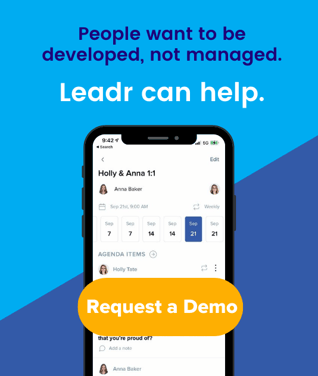Why Performance Improvement Plans (PiPs) Rarely Work
This blog was written by Leadr Board Member, Michael Erisman and originally posted on LinkedIn. Michael is the HR superstar who has developed teams for over 25 years at GE, Microsoft, Pushpay, and Leadr.
Many of us have no doubt experienced the ‘joy’ of trying to create a Performance Improvement Plan, or as they are commonly referred to, a "PiP". This is at best a very challenging endeavor for a manager who usually owns the entire process, and an unpleasant experience for the employee. Perhaps someone in HR told you to do this before you could remove a poor performer, or perhaps you are simply trying to articulate exactly what behaviors you need to see from the employee? In either case, the traditional approach - the manager writes the plan and the employee follows it - is often painful and unproductive.
The challenges in a traditional approach include making sure the plan is comprehensive enough to be clear, detailed enough to not allow for narrow short term improvements, and written in a way that minimizes potential misunderstandings (which are likely part of the root cause to begin with). Not easy.
Further, PiPs done in this way rarely work as a means to create lasting and consistent performance improvement. The goal is to manage and align performance and expectations along the way so that this process is never required to begin with, but there are situations when that does not happen, and when a PiP may be needed the traditional approach as described here is rarely successful.
There is a much better way.
Why Don't Traditional PiPs Work?
Let’s start with a reason the typical approach doesn’t work. Performance is not the sole responsibility of the manager, nor of the employee. Yes, you read that correctly. Managers are responsible for setting clear goals and accountabilities, removing barriers and providing support, and ensuring that expectations and gaps are clear. The employee owns whether or not they will perform the tasks and role responsibilities as outlined. So, why are most PiPs written exclusively by the manager? Why are most PiPs focused exclusively on the employee's performance and not on the context or importance of the work?
An approach I developed several years ago has changed this dynamic and works very well in most cases. The approach is simple, and follows two basic operating principles:
- The Manager is responsible for clearly articulating what is expected in the role, outlining the current level of performance, specifically identifying the performance gaps, and stressing why those gaps are important.
- The Employee is then responsible for writing a plan that specifically addresses the gaps and clearly articulates what the employee will do differently to achieve the required outcome.
The reason this process is effective is that it places the responsibility correctly on both parties. We do this process in writing so there is less opportunity for errors and misunderstandings.
A New Kind of PiP
What typically follows is one of these outcomes:
- The employee writes a plan that addresses the gaps and will ensure their performance is sustained at an acceptable level. The benefit here is that the employee buys in to this process, because it is their plan. The manager’s role is pretty easy, to hold the employee accountable to what they said they would do. This is the ideal outcome. I have seen great success with this.
- The employee comes back with a written plan that does not address the performance gaps. Usually this is due to a lack of clarity on what is expected, or some roadblocks that may be in place. In this case, it allows both parties to iterate until an effective plan is created that both agree is acceptable. This process will quickly help illuminate the reality that performance is a shared responsibility, and both parties own a role in the outcome. In fact, a root cause may well be that the manager has not clearly articulated expectations or removed roadblocks. A new plan that addresses both sides is essential. This requires that managers be open to understanding barriers, a lack of resources, or goal clarity that may be contributing to the lack of desired performance outcomes.
- The employee self-selects out of the role and chooses to leave, not wanting to commit to a plan, that they know they will be held accountable to, in order to get their performance up to the level required. While many may see attrition as a problem, it is always better to have someone in a role who is committed to the effort required to be successful.
Any of these three outcomes can produce a favorable result. While not always resulting in a successful improvement of performance, there is rarely a situation where the employee can claim the process is unfair. That is the key. A process must be perceived as fair, and consider the accountability of both parties. Further, it allows for the employee to articulate where the manager may need to clarify expectations or provide support.
The process holds both parties appropriately accountable to work together, as opposed to being a one-sided approach led solely by the manager. This approach engages both parties in the solution, as both parties are accountable for performance. The approach is simple and easy to articulate, and when done in a spirit of mutual accountability can be very successful!
If you do find yourself in a situation where the best way to help a team member grow is through a performance improvement plan, we’ve got you covered. We put together a template that helps you focus on the facts and work through the problem at hand in a way that puts employee growth first. Download our free template here.
Here are 5 other blogs to help you navigate leadership challenges:
7 Tips For Giving Negative Feedback
Want Better 1:1s? Start With These 100 Questions
How-to: The Guide to Setting Goals that Actually Work
Strengthening Your Leadership Development Program
Leadr helps you track goals, performance, and leadership development opportunities all in one platform. Request a demo with our team to see how our software can help you engage and grow every person on your team.
Share this
You May Also Like
These Related Stories

4 Tools To Tackle Poor Performance

The Complicated Relationship Between Pay & Performance





No Comments Yet
Let us know what you think